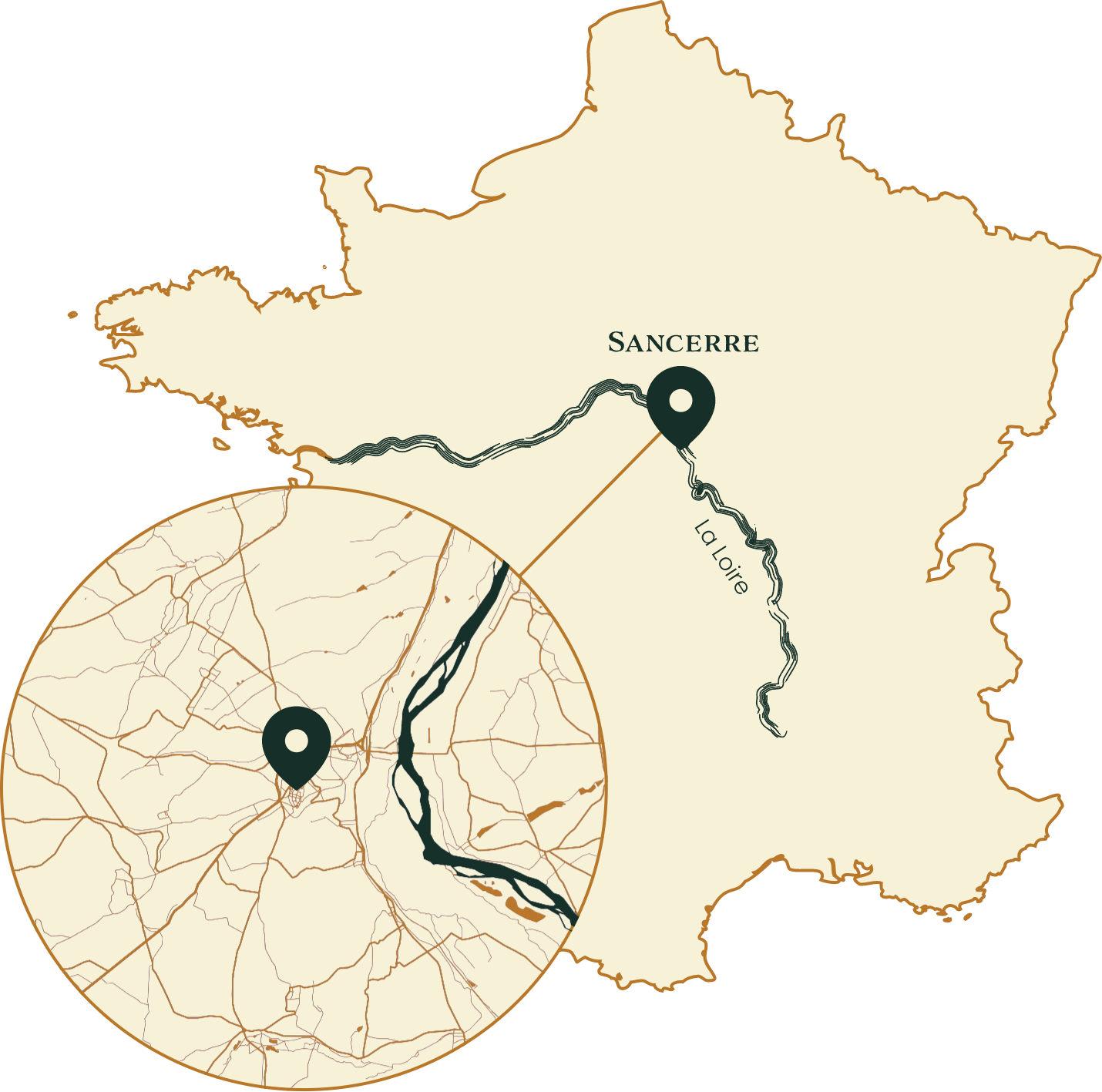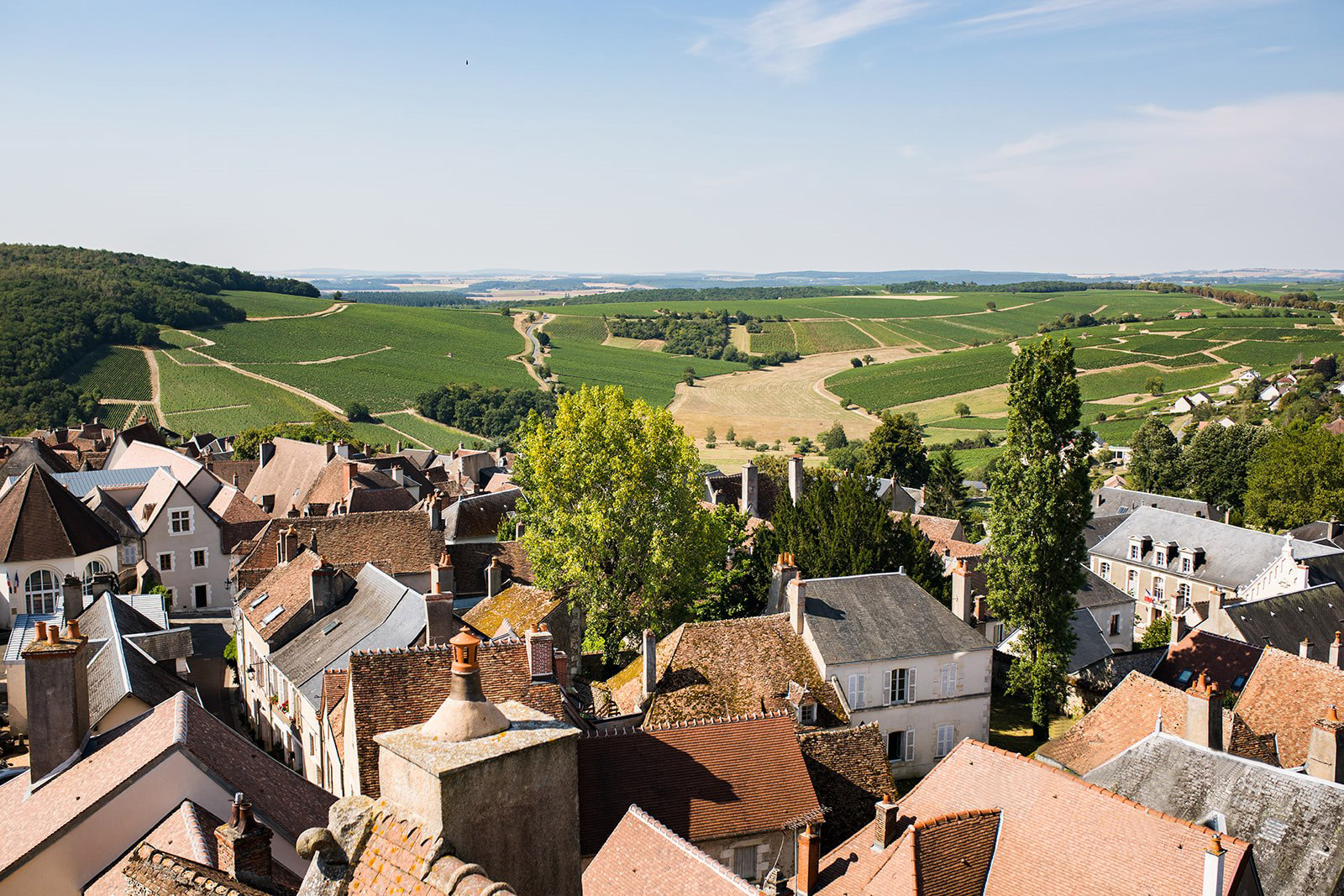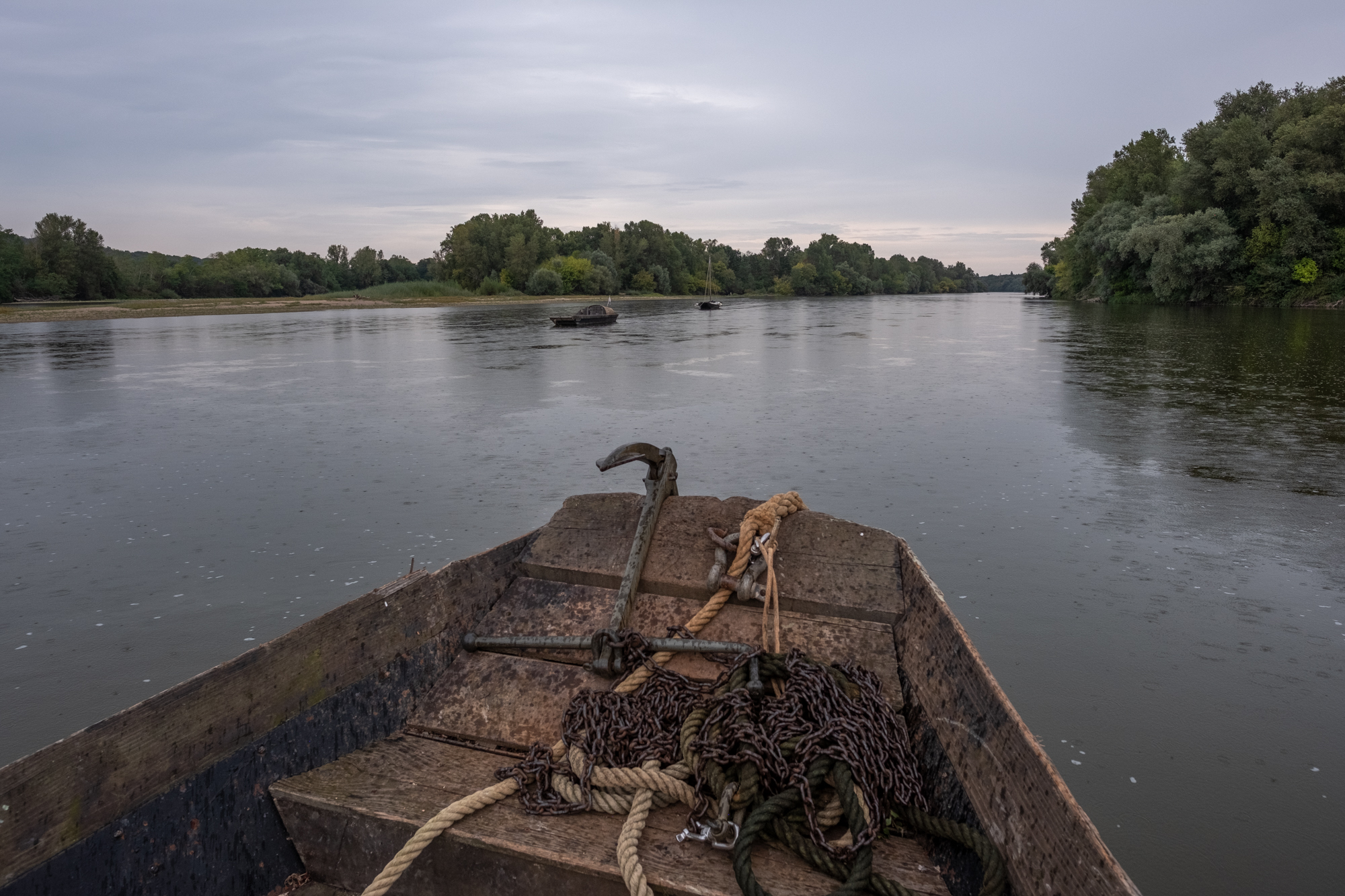


The wines from the terroirs of Sancerre originate in the northern part of the Upper Berry, a hilly area located in the Centre-Val de Loire region’s Cher department, in the heart of France. This winegrowing region is located only a few kilometres from neighbouring Burgundy, and lies on the left bank of the Loire River against the east-facing slopes of hilly reliefs.
These exceptional landscapes, formed by a geological accident, are comprised of the famed hill of Sancerre, the cuesta that opens up toward the Pays-Fort and the majestic wild Loire Valley. Men and women have gradually turned the area’s steep hills into viticultural land that is surprisingly homogenous and unique but that exalts the distinctiveness of each subsoil. These are terroirs that we, winegrowers of the Sancerre region, have inherited from nature, that we maintain and preserve and will pass on to future generations. We want you too to share in the wealth of diversity and subtlety that Sancerre has to offer.

Our Sancerre wines, just like our growers, are a part of the Centre-Loire Wines family, which is composed of 10 winegrowing areas that include 8 AOPs and 2 IGPs and brings together a collective of vine and wine artisans who convey the expression of their terroirs with elegance and sincerity on a daily basis.
Learn moreOur vineyards are ideally situated between :
Our area of appellation covers a small surface area measuring 10 km by 15 km, or 3,025 hectares. The 14 communes and 3 hamlets, with nearly 300 winegrowing families, united as a collective, have managed the vineyards for several generations.





Vines have thrived in Sancerre for many centuries.
Although texts dating back to 767 AD testify to the fact that vineyards existed in the area, it was between the 10th and 13th centuries that wine production really began to take off. As early as the Middle Ages, Sancerre was producing a reputable white wine that was served at the tables of the King of France and the Popes, after being shipped from the port of Saint-Thibault along the Loire.
The notion of “climat”, which designates a particular plot (defined by its soil profile and the quality of the wine it produces) appeared in 1482 – and it was during the Renaissance that the wine produced began to be exported to northern Europe, Flanders and England. The vineyards and the specificities of their subsoil quickly began to be studied in depth by local scholars. In 1777, the abbot Poupart, in his history of Sancerre, wrote : “It could very well be that there is no terroir that is more divided and differentiated than that found in the Mountains of the Sancerre region. The many ravines all contain veins of different soil types”.
Around 1885, the vineyards were hit by phylloxera, a destructive aphid that attacked the vines and eradicated all of the vineyards. Following that catastrophe, the vineyards were planted primarily with Sauvignon Blanc grapes, which showcased the very best that the Sancerre region’s terroirs had to offer, though some Pinot Noir vines were maintained. The phylloxera epidemic also resulted in the formation of a winegrowers’ collective and throughout the 20th century, the women and men working in the vineyards and at the wineries put all their efforts into improving the quality of their wines, the result of which was being granted AOC recognition, first in 1936 for white Sancerre, then in 1959 for the reds and rosés.
Since the 1950s, numerous collective initiatives have been implemented so that the quest for excellence may continue.

Our memorable wines, with their subtle aromas and flavours, are single varietal wines and are available in three colours. White Sancerre is crafted from 100% Sauvignon Blanc grapes while the red and rosé Sancerre are 100% Pinot Noir. Our production is divided as follows : 80% white wines, 13% reds and 7% rosés.
SAUVIGNON BLANC
PINOT NOIR
The alchemy between terroirs and climate is what lies behind the remarkable diversity of our wines. Influenced by a temperate climate, the diversity of the terroirs gives way to the expression of the finest aromas and flavours, and lend it its characteristic freshness.
Within a unique, giant geological layer cake, three main types of terroirs can be identified : “terres blanches”, “caillottes” and the siliceous clay soil commonly known as flint.

The Kimmeridgian marls are locally known as “terres blanches” (white earth) because the soil is composed of thick layers of marls, interspersed with limestone. They were formed during the Jurassic period, between 157.3 and 152.1 million years ago. These “terres blanches” make up 40% of the vineyards. They are found on the steeper slopes in the western part of the appellation.
The “terres blanches” with a higher proportion of clay yield a white Sancerre that is complex, robust and round and will open up after some time in the cellar.
The very stony soil that makes up the “caillottes” terroir is older, having formed between 163.5 and 157.3 million years ago. It also covers 40% of the surface area under vine, and are located between the “terres blanches” and the village of Sancerre, as well as in Bué, Chavignol, Amigny and Verdigny. They can be identified by coarse shards of compact white limestone.


Siliceous clay soil accounts for the smallest of the main terroirs, representing approximately 15% of the surface area under vine. Its clay formations are the thinnest and youngest layers in the Sancerre region (dating back 56 to 33.9 million years). The soil contains flint, which provides the vines with continuous warmth. This terroir can be found at the summits and on the slopes of the large hills in the eastern part of the Sancerre region, especially in Sancerre, Saint-Satur, Ménétréol-sous-Sancerre and Bannon.
Tasting a Sancerre, whether it be white or red, is like setting off on an adventure into a complex, incomparable dimension of aromas and flavours.
Sancerre’s reputation is well established and for good reason.
Two noble grape varieties: Pinot Noir and Sauvignon Blanc, which allow each cuvée to express their unique, coveted terroirs.
Sancerre Sauvignon Blanc will always be king when it comes to the harmony between delicate citrus fruit, verging at times toward exotic fruits, and featuring lively, mineral tautness imparted by the soils that are the pride of the appellation.
Depending on whether the grapes were grown on flint, “caillottes” or “terres blanches” terroirs, the white wines they yield offer perfect balance between rich substance and vivacity, always with bold minerality on the finish.

Sancerre’s unique terroirs express the quintessence of Pinot Noir grapes. Elegance and finesse are the key words to describe these red wines. Although the dominant aromas and flavours of Sancerre reds are evocative of juicy red and black fruit, typical notes of fine, subtle peppery spices reinforce the character of these unrivalled wines.
The palate boasts roundness, density, freshness and crisp, satin-smooth to fleshy tannins depending on the terroir.

Crisp and delectable, Pinot Noir expresses its generous palette of aromas and flavours through its Sancerre rosés. These wines are a real fruit basket, from the tanginess of red berries to exquisite orchard fruit scents on the nose. On the palate, Sancerre rosés boast a pleasing mineral framework with a hint of spice, which makes these wines excellent matches for food.


Obviously, the Sancerre appellation is also subjected to the vintage effect, which is linked to the year’s climate and particularly to the meteorological conditions that arise during the vine’s growing and ripening phases (from spring up until the harvest). Even if the wine results from a combination of the grapes’ ripeness and the winemaker’s skill during the vinification process, each year stands out from the others.
It is of common belief that Sancerre wines are meant to be enjoyed in their youth. However, the fabulous terroirs of the Sancerre region enable both the Pinot Noir and the Sauvignon Blanc grapes to yield wines that are suitable for laying down.
Many producers vinify and age their wines so that they have good cellaring potential, from 10 to 20 years for the best vintages.
The complexity of Sancerre wines, reds and whites alike, is unrivalled. The tertiary aromas that surface often lend incredible floral or fruity freshness that lingers. It is due to the Sancerre region’s unique terroirs that its wines can stand up to ageing and cellaring.
The white wines intended for laying down may be left for a few years without any problem. From 3 to 10 years or more for the great vintages, for wines from flint or “terres blanches” terroirs, for example.
The Sauvignon Blanc wines conserve all of their vivacity and fresh fruit for up to 5 years. After that, the first signs of evolution start to be detected on the nose, oscillating between tertiary notes that can be influenced by two different styles - either reductive, with noble vegetal, truffle or even asparagus notes, both on the nose and palate, or oxidative, which lends a more scrumptious aspect, evocative of honey or candied fruit.
The Pinot Noirs are also suited to be enjoyed as young wines or cellared for several years - 5 years for all of the red wines produced in the Sancerre region, and from 15 to 20 years or more, depending on the vintage and vinification methods.
Short vatting times yield wines that are ready to drink in their youth, with a focus on fresh fruit. On the other hand, prolonged vatting and ageing allow Sancerre’s red wines to be cellared for a very long time under good conditions. The style depends largely on the vintage : the cold vintages, such as 2011, 2014 or 2021 result in wines that evolve towards a profile reminiscent of humus, forest undergrowth or cherrystone, while the warmer, hotter vintages, such as 2009, 2015 or 2018, yield wines that age more slowly, and evolve towards a jammier profile featuring stewed fruit, prune, and leather.
The rosés are usually enjoyed in their early youth, to best appreciate these wines’ vivacity and crispness. But Sancerre rosés, principally those from “solar” vintages, show good ageing potential. A few years in the cellar gives the wines complex aromas and denser texture. Make way for delectable notes of nuts, mirabelle plums, baked goods, even floral notes that are rarely found in young rosés. After a few years in the cellar, these rosés prove to be the ideal match for food, thus earning them the designation of “gastronomic” rosés.